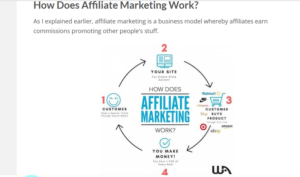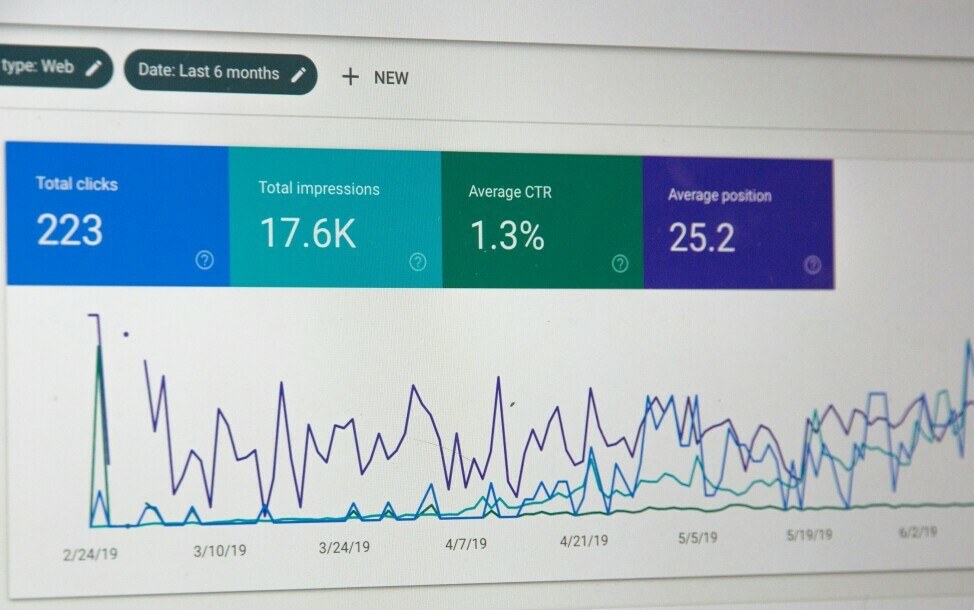Affiliate Marketing– Solving the mystery
You’ve probably heard about affiliate marketing and its ability to generate income, but what exactly is it? At its core, affiliate marketing is a performance-based business model where you, the affiliate, earn a commission by promoting someone else’s products or services. It’s an attractive way to create an income stream because you don’t need to develop your product; you simply link up with brands and spread the word.
Nowadays, you’re going to find out about how affiliate marketing is skyrocketing due to the ease of internet access and the growth of social media. As more businesses embrace online retail, there’s a massive demand for affiliates to bridge the gap between consumers and products. This isn’t just about making a few sales; it’s also about being a part of the digital economy’s expansion.
If you want to tap into this world, you should understand that this is not a get-rich-quick scheme. Successful affiliate marketing hinges on trust and transparency, key components of building a long-term income. Affiliate marketing can complement your current job or even become a full-time career if you’re willing to invest time and effort into creating valuable content and nurturing your audience.
The next step, which I’m here to help you with, is assessing your skills and pinpointing a niche. This is critical to your success – choose something that resonates with you. Don’t worry too much about competition. If you’re passionate and knowledgeable, your unique perspective can still attract a loyal following.
Assessing Your Skills and Choosing a Niche
I’m going to be straight with you – finding your footing in affiliate marketing starts with a good look in the mirror. You’ve got to figure out what you’re good at and what gets you fired up. Why? Because those are the keys to choosing a niche you can thrive in.
This isn’t just about what you enjoy; it’s also about what you’re knowledgeable in. Your niche should reflect your expertise because that’s what will give your recommendations authenticity – and authenticity sells. Don’t worry too much about whether your interest seems profitable at first glance. You’d be surprised at the niches out there making decent money.
Now, how do you lock down that perfect niche? Research, research, research. Look into trends, check out forums, read blogs, and analyze what the competition’s up to. Pick something that resonates with you and has a clear audience. A niche that’s too broad will have you scattered, and too narrow might not have enough traffic. You’re aiming for that sweet spot – specific yet popular enough to attract a solid following.
And remember, as you’re carving out your corner of the affiliate marketing world, you can always adjust your approach down the road if something isn’t clicking. Your first attempt doesn’t need to be your last, but with thoughtful consideration, it just might be your best.
Once you’ve got your niche nailed down, you’re going to want to move into selecting the right affiliate programs and products to promote. That’s going to include weighing things like commission rates, product quality, and company reputation. But more on that in the next section.
Selecting the Right Affiliate Programs and Products
I’m going to let you in on a little secret: the success of your affiliate marketing journey hinges on the programs and products you choose. Here’s why picking the right ones can make all the difference: the products must not only align with your niche but also resonate with your audience’s needs and preferences. Now, let’s talk about how to nail this crucial step.
First up, you’re going to want to look at the commission rates. Higher percentages can be tempting, but they aren’t the only factor to consider. Think about the product’s price, the likelihood of repeated purchases, and the brand’s reputation—after all, your recommendation is a reflection of your brand.
Next, you’re going to find out about the affiliate program’s cookie duration. When you refer a visitor, that cookie tracks them. The longer the cookie length, the more time you have to earn a commission if they decide to make a purchase later.
It’s smart to tap into different affiliate networks to see a variety of offerings. This includes companies such as Amazon Associates, Commission Junction (CJ), and ShareASale. They provide access to multiple brands and products, which gives you more flexibility to test and see what works best for your audience.
And don’t worry too much about picking the perfect product from the get-go. You can always adjust your approach down the road. Focus on finding products that you believe in and that you can authentically promote. If you use and love a product, your personal experience can become a powerful selling point.
Choose something that resonates with you, because your enthusiasm can be infectious and compel your audience to take action. That’s the strategy I like to leverage and trust me, it works.
Once you have your products and programs lined up, your next move is to create content that showcases these offerings in the best light. And getting this part right is critical—it’s not just about presenting the products, but also about providing value to your readers. That’s a perfect segue into the next section where I’ll cover how to produce quality content that converts.
Creating Quality Content That Converts
Now, when it comes to affiliate marketing, your content isn’t just a vehicle for your affiliate links; it’s the very heart of your strategy. It’s what attracts your audience, builds trust, and ultimately, influences their purchasing decisions. I’m going to walk you through how to create content that not only draws readers in but also encourages them to click through and make a purchase.
Firstly, every piece of content should provide substantial value to your readers. This means offering in-depth information, personal insights, or unique takes on your niche topic. You aim to establish yourself as a go-to resource, the kind of place where people land and think, ‘This is exactly what I’ve been looking for!’
Next, focus on the quality. Quality matters more than quantity—always. Ensure that your texts, videos, or podcasts are well-researched and polished. A typo might be a small mistake, but it can chip away at that all-important trust. I’d recommend always going through a checklist before publishing: Is my content solving a problem? Is it engaging? Have I backed up my claims with evidence?
When it comes to integrating affiliate links, subtlety is your ally. Links should feel like a natural extension of your content, not a sales pitch. Maybe it’s a ‘product review’ that gives honest, balanced insight, or a ‘how-to guide’ that mentions a tool you genuinely use and love. Your readers are smart—they’ll pick up on sincerity, or the lack thereof, instantly.
Now, authenticity also plays a huge role. Share your personal experiences with the products. When you can say, ‘I’ve tried this, and here’s what happened,’ you’re providing that firsthand experience that’s invaluable to someone on the fence about a purchase.
Remember, it’s not just about making a sale today. It’s about building a relationship with your audience that will lead to repeat sales. By focusing on creating rich, authentic content, you lay the foundation for a loyal following who trusts your recommendations.
You can always experiment with different content formats to see what your audience prefers. Whether it’s reviews, tutorials, or comparison pieces, vary your approach and keep track of what works. This strategy is essential because, in the next section, we’re going to tackle how to bring more eyes to your fantastic content. That’s right, we’ll delve into driving traffic to your affiliate content—which is a game-changer in amplifying your success. 
Driving Traffic to Your Affiliate Content
You can create the most engaging, informative content in the world, but it won’t make a dime if no one sees it. That’s where driving traffic comes into play. After all, traffic is the lifeblood of affiliate marketing.
Understanding the different traffic sources is crucial and using them effectively can make or break your affiliate marketing efforts. There are two main types: organic and paid traffic. Organic traffic comes from search engines, and it’s free. Paid traffic, on the other hand, is exactly what it sounds like – you pay for it, through ads on various platforms like Google, Facebook, and Instagram.
Now, if you want your affiliate marketing venture to succeed for the long haul, you need to get serious about SEO. It stands for Search Engine Optimization, and it’s all about making your content friendly to search engines like Google. Why is this important? Because the higher you rank in search results, the more organic traffic you get, and that’s very good for business.
Let’s talk about keywords for a second. These are the terms people type into search engines when looking for something, and your content needs to include these. But not just any keywords, the ‘right’ ones. Performing keyword research can help you uncover what your potential customers are searching for and tailor your content to answer their questions.
We can’t overlook the power of social media either. Nowadays, everyone’s on one platform or another, which makes it a fantastic place to reach potential customers. Share your content, engage with your audience, and don’t shy away from investing a little in social media ads. They can go a long way.
Don’t forget about email marketing. It’s one of the most cost-effective strategies to keep your audience engaged. By sending regular newsletters with updates and valuable content, you’ll stay on their minds. When they’re ready to make a purchase, they’ll remember you.
Driving traffic isn’t something you do once and forget about. You’ve got to keep at it, consistently producing outstanding content, optimizing your SEO strategy, and engaging with your audience on social media and through email. It’s about finding what works for you and doing more of it.
As you sharpen your traffic-driving skills, you’ll want to measure your performance carefully—that’s your gateway to optimizing your affiliate marketing strategy. But more on that in the next section.
Measuring and Optimizing Your Affiliate Performance
So, you’ve got your affiliate marketing strategies in motion, and you’re starting to see some traffic. That’s great, but there’s more work to be done. I’m going to help you understand why it’s vital to keep tabs on your performance and how to make those figures work for you.
First up, you’ll need to have the right tools at your disposal. Tools like Google Analytics, affiliate dashboards, and conversion tracking systems give you deep insights into what’s working. You’re not just looking at page views or clicks; you’re analyzing behaviors and patterns. Patterns that can tell you a lot about your audience and the effectiveness of your content.
Once you’ve gathered your data, it’s time to get analytical. You’re going to evaluate what types of content are pulling in the most revenue, which traffic sources are the golden geese, and which products resonate the most with your audience. Sometimes, it’s just a tiny tweak in your call-to-action or a better product image that can make all the difference.
And while it’s awesome to celebrate the wins, it’s equally important to recognize and learn from the tactics that aren’t paying off. In my opinion, there’s no such thing as failure in this space—only lessons that help you refine your approach.
Don’t worry too much about fluctuations; they’re normal. But when you do spot a consistent downward trend, it’s a signal to pivot or patch up your strategy. Remember, affiliate marketing is an evolving landscape. Strategies that were effective last year may not cut it today. Always be learning, testing, and adapting.
Choose something that resonates with you when it comes to methods of optimization. Maybe it’s creating a more engaging email marketing campaign, or perhaps it’s investing in better SEO for your website. The key is to never stay static.
Keep in mind, that  you can always adjust your approach down the road. What’s essential is that you’re proactive about it. Set up regular intervals to review your analytics so you can be quick on your feet, making necessary adjustments.
you can always adjust your approach down the road. What’s essential is that you’re proactive about it. Set up regular intervals to review your analytics so you can be quick on your feet, making necessary adjustments.
Lastly, a part of staying relevant is staying informed. Keep abreast of changes in affiliate marketing by joining forums, following influencers in the space, and attending webinars. Knowledge is power, especially in an industry that evolves as quickly as affiliate marketing.
In closing, if you’re dedicated to measuring and optimizing, the opportunities in affiliate marketing are endless. I love it. It’s great. You’ve got an exciting journey ahead, and I hope that you find success and fulfillment in your affiliate marketing endeavors.
Thank you for reading my article and good luck in all of your future endeavors, Deanna
